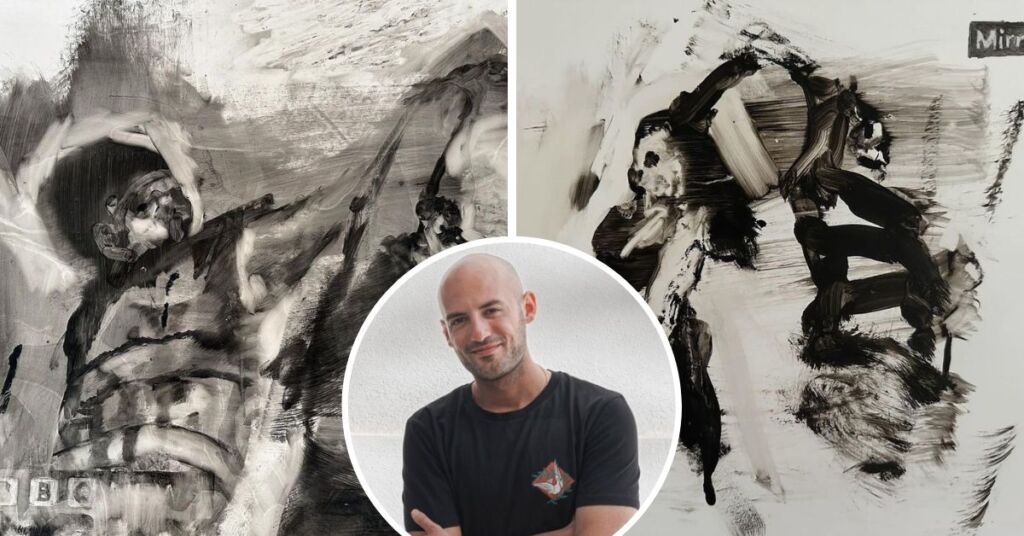Guest Post: A Lesson To Learn From British Artist Of Maltese-Descent Antony Micallef

Just last week I stood in the studio of celebrated British contemporary artist Antony Micallef. You’ve read that right. The surname is in fact Maltese, and the link directs you to only one of the many reviews that talk of his success. I have been a close follower of his work for some time. He almost sculpts with paint in a striking rethinking of the portrait — but it is not this fascinating, captivating style which draws my attention this time.
My reason for writing was released a short while ago to his Instagram feed. On the floorboards of his Notting Hill studio, Micallef showed me the most impressive drawings which he planned on releasing ahead of the snap elections announced by Rishi Sunak for July 4th.
In a series of drawings, Micallef chose to borrow from the photos of the lockdown parties that took place at Number 10 at the height of the pandemic. Arguably just one of the incidents that has plagued the Tory government over the past legislature, he juxtaposes them on images from another time, the dancing mania epidemic which features in, amongst others, drawings by Brueghel:
“Dancing mania also known as the dancing plague and the St. Vitus’ Dance was a social phenomenon that may have had biological causes, which occurred primarily in mainland Europe between the 14th and 17th centuries. It involved groups of people dancing erratically, sometimes thousands at a time. The mania affected adults and children who danced until they collapsed from exhaustion and injuries, and sometimes died…
…Affecting thousands of people across several centuries, dancing mania was not an isolated event and was well documented in contemporary reports. It was nevertheless poorly understood, and remedies were based on guesswork.
Often musicians accompanied dancers, due to a belief that music would treat the mania, but this tactic sometimes backfired by encouraging more to join in. There is no consensus among modern-day scholars as to the cause of dancing mania.
During our own pandemic there were secret parties at number 10 where our own politicians danced crazily while the rest of the country had to endure strict lock-down rules, that our own government enforced and carelessly flaunted under the Johnson government. My drawings are loosely based on the 1642 engraving by Hendrick Hondius after a 1564 drawing by Pieter Brueghel the Elder.”
I think there is much to learn from what this artist of Maltese descent is doing. He is holding to account, in a way that artists have done for centuries. Reframing a story, and borrowing from popular imagery it speaks loudly about what he wants this election to be about. It is an artwork that calls for this to be a vote of confidence, and he is making it accessible to the public. Purchases for prints in aid of a local charity will be made available soon.
Governments everywhere are failing us and the politicians we are being invited to elect stopped (in their majority) being inspiring a while ago. The work artists create is political not just because of the hands that create them but also because of the times in which they are thought of. Artists have the chance to create strong images that speak of the realities their politicians are subjecting them to, but also stand up to remind them that they are the ones serving, and not the other way round. To do this they use strong visual (and other) language for us to share in. Micallef’s work has done this before. When his portraits of President Donald Trump on a packet of Marlboro cigarettes went viral a few years ago, his message was clear. Now with Partygate he is once more providing the image for people to rally behind.
In Malta, we too have been living an intensely political moment for some time now and our art is a chance to rally our ideas and statements together. Not only of protest and commentary — but also of hope. The stories that are being released are often hard to understand directly. They continue to build on the unbelievable stories we’ve lived with for a decade now. Dancing in the garden will have started a movement way before Micallef appropriated it but his images will create a chance for the people to join in public disdain.
We are just out of an election campaign that was riddled with fodder for us to consume and dwell upon. Artists the likes of Ed Dingli, Keit Bonnici, Alexandra Alden and Seb Tanti Burlo are no strangers to politically charged work making viral impact across social media. As we expect more headlines to shake the ground our island is built on, more unbelievably low standards to dishearten the public more and face the onset of potential power cuts like last week’s in the summer ahead, I think we should take a page out of Micallef’s book. In his studio and on his Instagram feed what I saw in Antony’s statement felt incredibly Maltese.
Lovin Malta is open to interesting, compelling guest posts from third parties. These opinion pieces do not necessarily reflect the views of the company. Submit your piece at [email protected]
